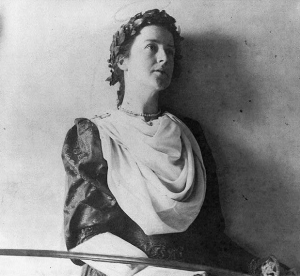During the Enlightenment, that great period of intellectual exploration in the 18th Century, a group of educated Englishwomen, tired of being excluded from “masculine” literary and artistic discourse, banded together to form a celebrated salon known as the Blue Stockings Society. It flourished for about half a century, attracting prominent guests such as Samuel Johnson and Horace Walpole. But by the 19th Century, its popularity had waned, and the term “bluestocking” became a pejorative one for any intellectual woman — stereotyped as a frumpy spinster with literary pretensions.

Louise Imogen Guiney as St. Barbara,
by Fred Holland Day.
As with all stereotypes, that view did a profound disservice to its targets. In 19th Century America, New England produced a rich vein of female literary talent. While those like Emily Dickinson and Louisa May Alcott take center stage today, there were others of great ability but lesser renown whose works deserve a revival. The poet and essayist Louise Imogen Guiney (1861-1920) is one of them.
Guiney was born in Roxbury, Massachusetts, the daughter of an Irish-born Civil War hero and lawyer. She was educated at a Catholic convent school, but her father’s death in 1877 forced her to work to support herself and her mother, taking jobs as a postmistress in a small Massachusetts town and a cataloger at the Boston Public Library. Meanwhile, at 19, she launched her literary career with a poem, “Charles Sumner,” published in a Boston newspaper. Her critically acclaimed poetry collections, Songs at the Start (1884) and The White Sail (1887), soon followed.
Guiney also garnered a reputation as an incisive and learned essayist. Her first essay collection, Goose-Quill Papers (1885) shows off her scholarship as well as her wit and flair. The amusing essay “On Teaching One’s Grandmother How to Suck Eggs” gives us a tongue-in-cheek survey of the subject:
In the days of the schoolmen, when no vexed question went without its fair showing, it seems incredible that the proposition hereto affixed as a title provoked no labyrinthine reasoning from any of those musty and hair-splitting philosophers. Aristotle himself overlooked it; Duns Scotus and the noted Aureolus Philip Theophrastus Bombast de Hohenheim Paracelsus were content to repeat his sin of omission. Even that seventeenth-century English essayist and scholar, “whose understanding was wide as the terrene firmament,” neither unearthed the origin of this singular implied practice, nor attempted in any way to uphold or depreciate it. The phrase hath scarce the grace of an Oriental precept, and scarce the dignity of Rome. It might sooner appertain to Sparta, where the old were held in reverence, and where their education, in a burst of filial anxiety, might be prolonged beyond the usual term of mental receptivity.
After her initial successes, Guiney became a key part of Boston’s aesthetic revival of the 1890s, and counted among her friends the poet and physician Oliver Wendell Holmes (to whom Goose-Quill Papers is dedicated), the architect Ralph Adams Cram, the poet Bliss Carman, and the photographer Fred Holland Day. Her third poetry collection, A Roadside Harp (1893) sealed her reputation as a fine aesthetic poet, with some flourishes harking back to an earlier time, as in “Tryste Noel”:
The Ox he openeth wide the DooreAnd from the Snowe he calls her inne,And he hath seen her Smile therefore,Our Ladye without Sinne.Now soone from SleepeA Starre shall leap,And soone arrive both King and Hinde;Amen, Amen:But O, the place co’d I but finde!
Guiney began a new epoch in her life and work when she moved to England, where she liked “the velvety feel of the Past underfoot,” in 1901. She gave up poetry — her last collection, Happy Ending, was published in 1909 — and refocused much of her literary work on biographies of prominent English Catholics (Blessed Edmund Campion) and Irish historical figures (Robert Emmet). Her work was not lucrative, however, and she often went without food or coal in order to have enough money to buy books. She died of a stroke at her home in Gloucestershire in 1920.
Consistent with the stereotype of the bluestocking spinster, Guiney never married, and was said to share a “Boston marriage” with the writer Alice Brown. But, inconsistent with the stereotype, so far from being a frump, she was “tall and lithe. . . given to such outdoor pursuits as hiking,” as Douglass Shand-Tucci describes her in Boston Bohemia: 1881-1900. Guiney was not only “pretty, with beautiful dark gray eyes,” but also “warm and affectionate, even flirtatious, and altogether a buoyant free spirit with an irrepressible sense of humor.”
Guiney’s free spirit shines through in the dozen or so of her works available at Project Gutenberg. Her biographer, Henry G. Fairbanks, called her the “lost lady of American letters.” She deserves to be found again.
This post was contributed by Linda Cantoni, a Distributed Proofreaders volunteer.


Thanks for the review. Guiney sounds like an interesting woman. She’s one I have not heard of. I shall have to explore her works.